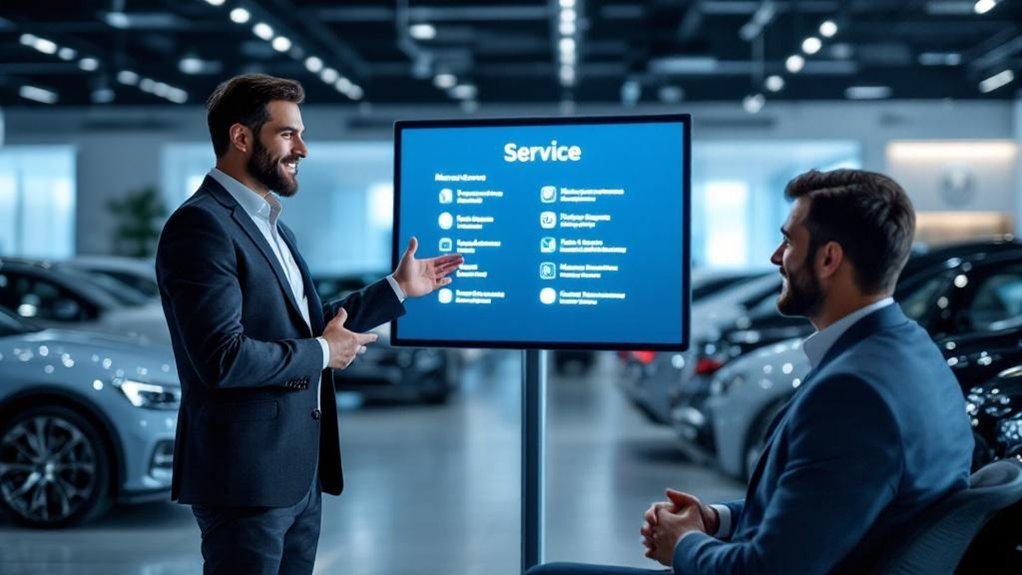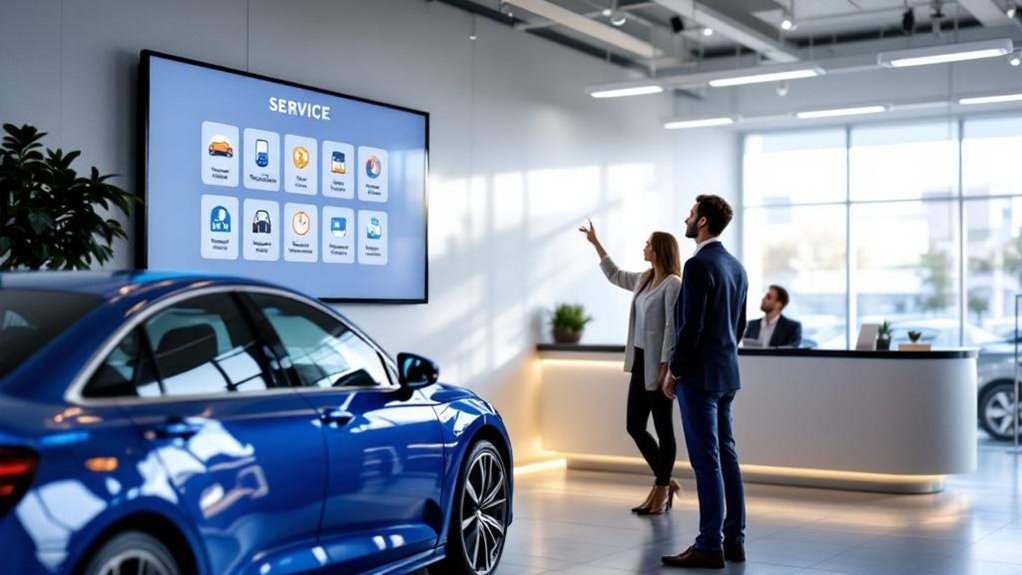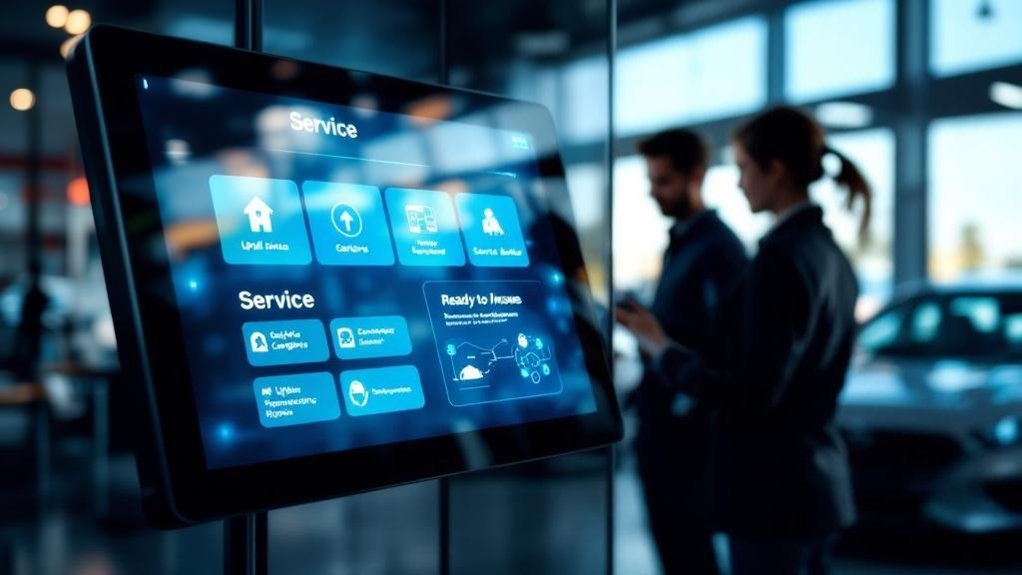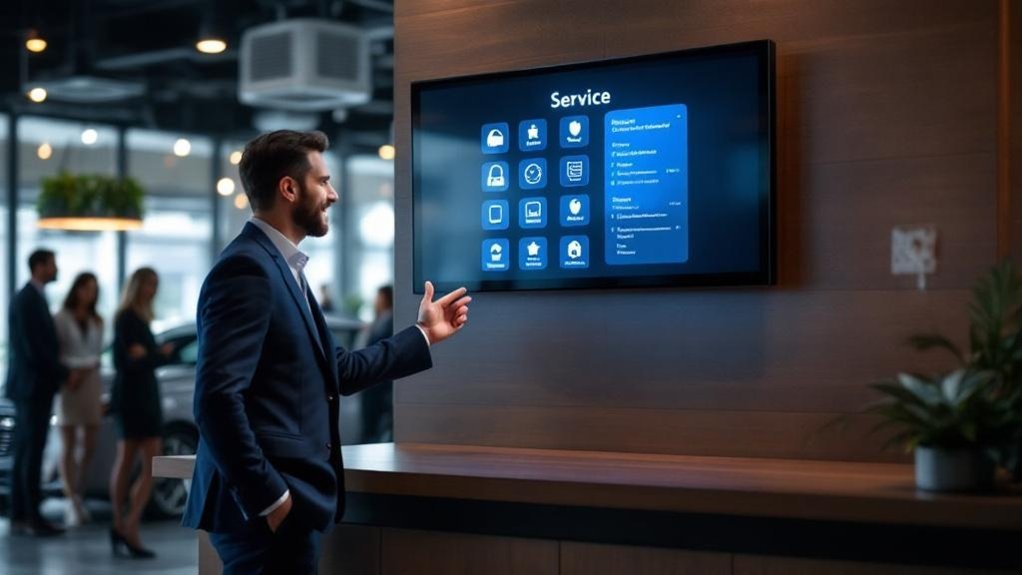You’ll cut advisor talk time and lift per-visit revenue by presenting customers with clear, personalized digital service menus that recommend targeted upsells and let them approve in seconds. UX-focused layouts and real-time vehicle history drive higher acceptance rates while integrated payments and status feeds speed transactions. Automated, AI-tailored bundles increase average ticket value and reduce manual advisor steps. Tie menus to inventory and analytics, monitor upsell conversion and talk-time metrics, and you’ll see measurable operational gains if you want to learn more.
Key Takeaways
- Present tailored service bundles based on vehicle history and maintenance needs to automate relevant upsell suggestions.
- Use guided self-service menus with clear pricing and customization to let customers add services without advisor intervention.
- Integrate real-time inventory, parts, and pricing to ensure instant, accurate upsell offers and approvals.
- Send targeted promotions and status updates to customers’ devices to capture timely add-on conversions.
- Track upsell conversion, advisor talk time, and average transaction value with dashboards to optimize offers and workflows.
Key Takeaways for Dealers and Customers

Wondering how digital service menus actually move the needle for both dealers and customers? You get measurable customer engagement gains by presenting tailored packages and automated upsells that match preferences, increasing average service revenue per visit. UX-focused layouts and clear descriptions cut advisor talk time, so staff handle exceptions and higher-value tasks. Operationally, real-time updates plus integrated payments speed transactions and shrink wait times, improving throughput. Personalized reminders and maintenance suggestions maintain repeat visits without manual outreach, supporting loyalty and predictable service demand. Together, these elements drive revenue growth while lowering per-transaction labor. Implemented thoughtfully, digital menus convert relevant opportunities into sales, streamline service operations, and create a more efficient, data-driven customer experience.
How Digital Service Menus Work in the Service Lane
When customers pull into the service lane, digital service menus let them see clear, itemized options—prices, warranties, and estimated times—so decisions get made faster and advisors spend less time explaining basics. You’ll rely on streamlined digital interface design to present service descriptions, costs, and warranty details that reduce questions and speed approvals. Real-time status updates cut advisor callbacks; access to service history enables targeted, relevant recommendations that improve customer engagement without extra conversation. Customization surfaces personalized packages, raising acceptance rates while lowering talk time. The result is measurable: faster throughput, higher attach rates, and better customer satisfaction.
| Emotion | Trigger |
|---|---|
| Relief | Clarity of options |
| Trust | Transparent pricing |
| Confidence | Service history |
| Satisfaction | Faster completion |
Features That Drive Automated Upsells

You’ve seen how clear, itemized menus speed decisions and cut advisor talk time; now look at the product features that turn that clarity into repeatable revenue. You’ll rely on data-driven, UX-first elements that enable automated recommendations and boost customer engagement without extra staff effort. Key features include:
- Tailored service bundles that use vehicle history and preferences to trigger context-sensitive upsells.
- Interactive customization controls letting customers add services, see immediate price/warranty impacts, and accept upsells.
- Real-time status and promotion feeds pushed to personal devices, prompting timely offers during service.
- Analytics dashboards that surface trend-based promotions and measure conversion rates for continuous optimization.
These features align ops, UX, and sales to scale profitable, predictable upsells.
Reducing Advisor Talk Time Without Sacrificing Service Quality
You can cut advisor talk time by designing a streamlined appointment intake that captures vehicle issues, service history, and preferred time slots up front, reducing back-and-forth calls by measurable percentages. Pair that with guided self-service upsells in the digital menu that present targeted, AI-recommended add-ons and clear pricing, so customers can accept or decline without lengthy explanations. Together these UX and ops changes free advisors for high-value interactions while maintaining or improving service acceptance rates.
Streamlined Appointment Intake
Because digital service menus let customers pick services and time slots themselves, advisors can cut intake talk time by up to 50% while keeping service quality high. You’ll improve customer convenience and appointment efficiency by shifting intake to a UX-designed flow that reduces manual steps and speeds decision-making. Automated scheduling drops response time from minutes to under 30 seconds, and AI booking prevents double bookings. Use real-time menu data to keep interactions short but informed.
- Immediate booking confirmation and reminders cut no-shows ~45–50%
- Sub-30s response times streamline advisor workload
- AI-driven slot management avoids conflicts and idle capacity
- Real-time service selections feed operations for accurate prep
This reduces talk time without lowering service standards.
Guided Self-Service Upsells
Having cut intake time and automated bookings, modern digital service menus can also shift upselling from advisor-led conversations to a guided self-service flow that boosts revenue without extra talk time. You’ll give customers empowerment by surfacing real-time vehicle history, side-by-side package comparisons, and personalized reminders so they can choose add-ons confidently. Data shows guided self-service upsells increase opportunities 20–25% and shorten advisor interaction by ~30%, while tailored promotions lift additional purchases 15–20%. From a UX and ops perspective, interactive comparisons and clear pricing reduce cognitive load and decision time, automating routine upsell strategies and preserving service quality. That frees advisors for complex consults, improves throughput, and creates measurable revenue gains without adding staff time.
Implementation Steps and Integration Best Practices

When integrating a digital service menu, start with a systems audit that maps data flows between your dealership management system, CRM, and shop schedulers so you can guarantee real-time inventory, pricing, and upsell availability; this foundation lets you deploy automated prompts, personalized package recommendations, and advisor workflows that cut talk time while preserving conversion rates. You’ll address integration challenges by documenting APIs, data schemas, and latency tolerances, then phase connections to limit disruption. Design UX for quick choices and clear advisor handoffs. Define training requirements tied to measured tasks so advisors practice concise confirmations and exception handling.
Start with a systems audit to map integrations, ensure real-time pricing and inventory, then design quick UX and concise advisor workflows.
- Map APIs, data owners, and sync cadence
- Prototype UI flows with real customer data
- Implement automated prompts and fallback rules
- Train advisors on short, outcome-focused scripts
Measuring Success: KPIs and ROI
You’ve set up systems, trained advisors, and rolled out UI flows—now measure whether those changes move the needle. Focus on success metrics tied to behavior and dollars: upsell rate (expect up to +30%), advisor talk time (-~20%), and average transaction value (+~25%). Use real-time analytics to segment by service preference, UI path, and promotion performance so UX tweaks are evidence-based.
Run weekly dashboard checks and A/B tests of messaging, capturing conversion lifts and time-on-task reductions. For profitability analysis, model incremental revenue per visit, margin on added services, and customer lifetime value shifts. With typical ROI realized in 6–12 months, prioritize fast feedback loops and operational standardization to sustain gains.
Frequently Asked Questions
What Is the Four Square Trick at a Car Dealership?
The four square’s a dealership strategy where you’ll see price, trade-in, down payment, and monthly payment separated into four boxes; it’s a data-driven, UX-focused ops tool that streamlines negotiation and surfaces upsell opportunities quickly.
How to Upsell as a Service Advisor?
You should use upselling techniques like personalized recommendations and bundled pricing, employ service advisor strategies backed by analytics, optimize UX for clear choices, track conversion metrics, and streamline ops to minimize talk time and boost revenue.
How Are Car Dealerships Using AI?
They’re using AI applications to analyze customer insights, automate personalized service recommendations, streamline scheduling and menus, cut advisor talk time, and optimize operations with data-driven UX improvements that boost conversion rates and operational efficiency.
Why Is It Essential to Focus on Local SEO in Digital Marketing for Car Dealerships?
Think of local SEO as a beacon guiding cars to your lot: you’ll capture local search intent, boost dealership visibility, convert mobile searches into visits, and optimize UX and operations with measurable, data-driven improvements that drive sales.
Conclusion
You’ll love how digital service menus quietly turn your advisors into efficiency gods: automated upsells based on vehicle data, UX-first prompts that boost acceptance rates, and measurable drops in talk time so ops run like Swiss clockwork. Sure, you’ll miss the awkward small talk, but your KPIs will thank you — higher ARO, faster throughput, better CSAT — all while customers get clearer choices and fewer sales pitches. Welcome to leaner service.
